Aber
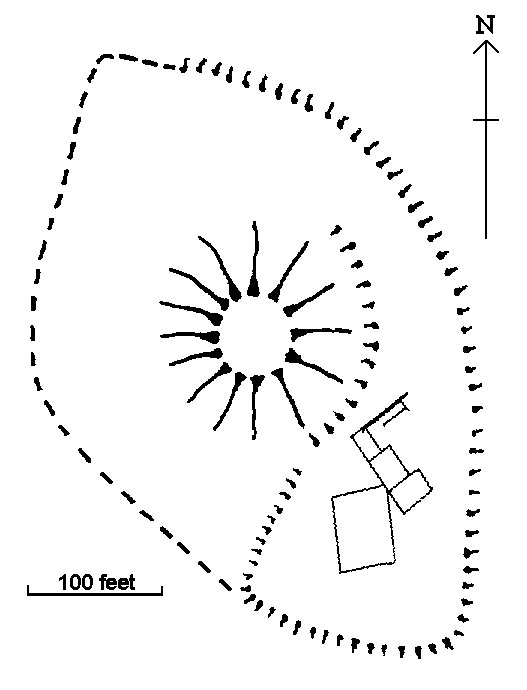 It is perilous to precisely date any medieval structure, with or
without archaeological or documentary evidence. This is
because it is difficult to be sure what structures documents refer to
and even what exactly archaeological evidence actually
signifies. This is as true for castles as for
llysoedd. In each case it is still a matter of weighing
possibilities and deciding likelihoods. However, this does
not mean that such dating should not be attempted, merely that it
should not be set in stone, especially while much of the evidence is
yet to be evaluated.
It is perilous to precisely date any medieval structure, with or
without archaeological or documentary evidence. This is
because it is difficult to be sure what structures documents refer to
and even what exactly archaeological evidence actually
signifies. This is as true for castles as for
llysoedd. In each case it is still a matter of weighing
possibilities and deciding likelihoods. However, this does
not mean that such dating should not be attempted, merely that it
should not be set in stone, especially while much of the evidence is
yet to be evaluated.
At Aber we have a still partially
ditched motte roughly 120' in diameter and a little over twenty
feet high. Such mottes literally abound throughout the
British Isles. The summit is approximately fifty feet in
diameter and shows clear signs of once having supported either a small
shell keep or large, probably round, tower. The motte was
almost certainly surrounded by a ditch as was common
practice. This is most noticeable to the south, although the
drop in height to the houses on the site of the bailey now marks its
position elsewhere. The motte appears to have been surrounded
by an eye-shaped bailey approximately 550' north to south by 350' east to west at its maximum extent. This bailey
itself would appear to have been divided roughly in half. The
dividing ditch survives mostly to the south, while to the north it may
be discernable in the aerial photograph. Most of the
bailey defences to the north and west have been obliterated by later
houses, but the distinct drop in height strongly suggests the line of
the northern bailey. The bailey defences to the south and
east have also been largely erased, possibly by ploughing, but more
likely by the deliberate destruction of the rampart which was probably
used to fill the ditch. Such degradation of the military earthworks of the site
should make us very careful of the modern suggestion that this was the
site of the hall complex of the later princes of Wales.
Within the northern bailey excavation
has uncovered a structure which has been ‘identified as the
llys or princely court recorded here through the thirteenth
century'. There are many problems with this identification
and it would appear - certainly no evidence has been advanced that any
proper historical research has been undertaken and certainly none
worthy of the name has been published - that this assertion has been
made without adequate historical research or taking llys and castle
sites in context.
The building alleged to be a royal llys
was uncovered twice, once in 1993 and once in 2010. This
structure was initially claimed to be approximately 37' east to
west by 26' north to south internally, with walls some
2½' thick. Projecting chambers, each about 20' by 30', have been claimed by the excavators as
additions built on both sides of ‘the hall'. It is
therefore necessary to examine the remains to see if they justify such
an interpretation.
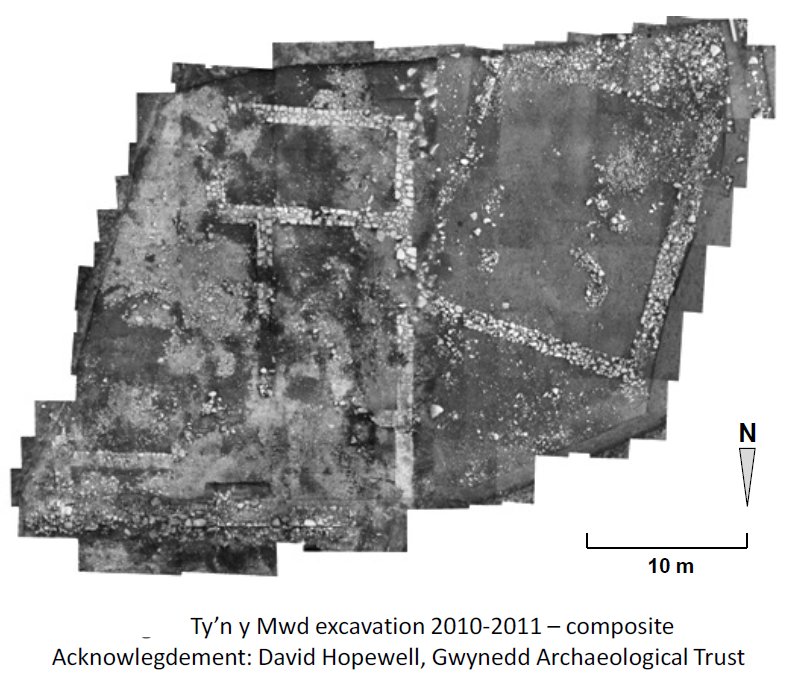
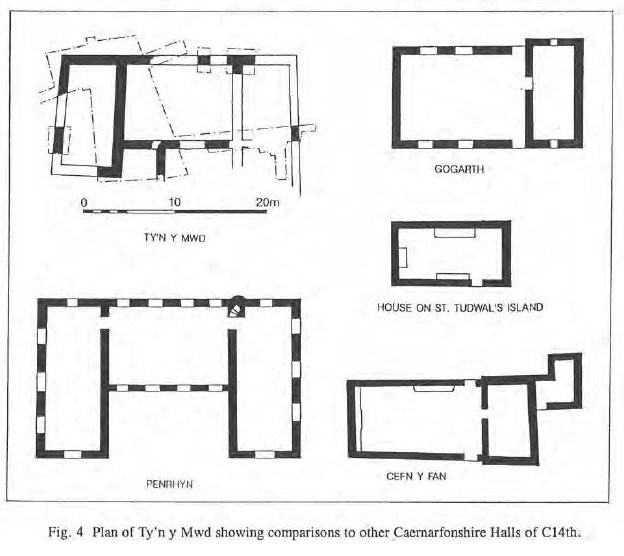 The aerial photographs of the dig site -
and a short personal inspection - would suggest the site has a complex
history which archaeology shows continued into the nineteenth century.
From the excavation reports we can judge that we are not yet anywhere
near to fully understanding the ‘modern' history of the
castle site after the Middle Ages.
The aerial photographs of the dig site -
and a short personal inspection - would suggest the site has a complex
history which archaeology shows continued into the nineteenth century.
From the excavation reports we can judge that we are not yet anywhere
near to fully understanding the ‘modern' history of the
castle site after the Middle Ages.
Firstly, a few things have to be said of
the reports that have appeared and which can be summed up in the last
government published report. These contain many claims, but
no historical research, while the few solid facts that they do contain
are used in juxtaposition with dubious identifications to
‘prove' their cause. Such a report even resorts to
‘straw man' arguments, viz: ‘Some believe that...
Pen y Bryn... [was the llys] quoting evidence from place names,
antiquarian writers, local tradition and interpretation...'.
Such misrepresentation of the facts from original thirteenth and
fourteenth century documentation does no real favours to history and is
an abomination from a government sponsored body. However,
using this final ‘preliminary report' as a basis for what has
been uncovered in the castle bailey, it is possible to make the
following observations. The south-western corner of a later
‘masonry building' has clearly penetrated the wall of the
claimed long house of the Welsh princes. For some
reason the excavators make this penetration out to be an original
doorway of their hall of the princes. If this was a doorway -
of which there seems no evidence - then why was a later building
apparently ‘of the fourteenth century' built into
it? What was this later ‘building' that shows
evidence of metal working going on within it? Was it a
building or a simple corral wall around an industrial complex
approximately 60' by 50', built after the demolition of the alleged
hall. Further, why is there no historical evidence of this
change of use of the site of a royal palace into an industrial complex
as has been uncovered by excavation, unless of course this is not the
site referred to in any of the documentation? Remember that
the capital messuage, or caput of Aber estate, as Garth Celyn was, is
mentioned as a functioning estate down to 1417 and is still being
granted by the Crown as such as late as 1485 and Pen y Bryn is
mentioned as the capital messuage of the estate of the Thomas family
during the sixteenth century.
Of the claimed ‘hall' itself,
understanding its NE section is even more problematic due to
the denuded nature of the remains, which are even worse at this
corner. The northern section of the primary building has been
almost totally obliterated with the NE corner totally
lost. The junction of the NW corner with the claimed
‘north wing' is not clear, but the better quality mortar in
the ‘wing' wall would suggest that it abuts onto the primary
chamber wall. The rest of the so called ‘north
wing' appears to be illusory, but more will be said of this later.
Two entrances have been claimed into the
‘hall house'. The first, to the east, is less than 3' wide and consists of a simple break in the wall without a
doorstep. As this is overshadowed by the claimed
‘wing' to the south and a later wall which abuts to the
north, it probably was an entrance of a very poor kind. It
would also appear to have been covered by an outbuilding or porch
judging by the remains. This is hardly the great porchless
ceremonial entrance which appears on the imaginative reconstruction of
the surprisingly misnamed ‘Ty'n y Mwd' hall. The
second ‘entrance' to the west, which we have already examined
above, is even more imaginative. This is simply a gash carved
through the wall where the later, apparently industrial complex was cut
through what therefore appears to be an abandoned primary
building. If the building was occupied and of a high status
it would not have been pierced by such a lowly structure.
The building claimed as the southern
‘wing' of the ‘hall' is 35' by 16'
internally. The foundations of this chamber are mostly
intact, although much of the east wall has gone. It appears
to all be of one build except for a later external buttress added
roughly half way down the southern wall. That the eastern
wall of the ‘hall' penetrates the northern wall would suggest
that it post dates this structure. However, it could just be
a change in building plan that happened virtually contemporaneously
with the building of the ‘hall'. A
‘bronze ring brooch... of thirteenth to fourteenth century
date' was recovered ‘from the interface of the old ground
surface within the south wing of the building'. This would
‘suggest' that the brooch was lost after the building was
abandoned and before much soil built up. It is hardly
satisfactory dating material and if anything points to a pre fourteenth
century date for the abandonment of this structure. If this
assumption is correct, it shows that this could not have been the
palace of the princes as this was still in occupation in the
fifteenth century.
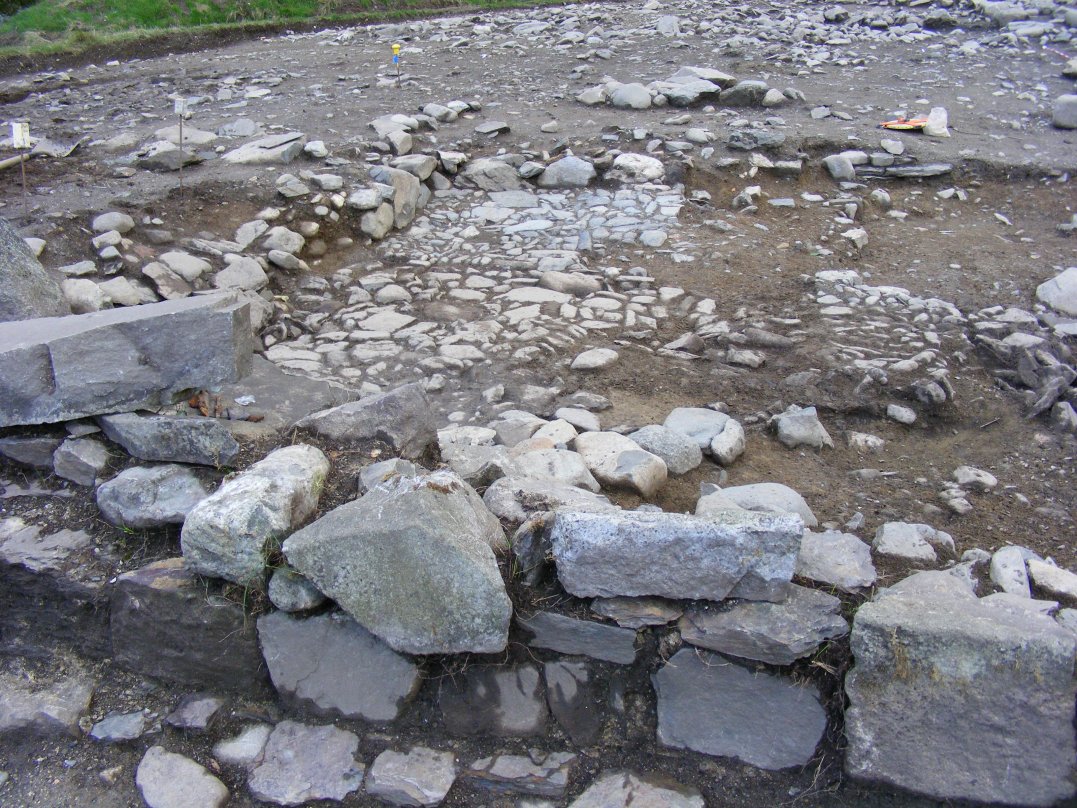 The northern part of the excavation site
shows at least four or five phases and has obviously had a more complex
history than the two structures to the south, identified by Gwynedd
Archaeological Trust (GAT) as a hall and its later wing. This
northern section is also the best preserved part of the masonry and the
thickest, with the wall approaching 6' thick. In front
of the northernmost wall was a ditch which was not fully explored by
the excavators. This is a shame as it would appear to have
been the ditch dividing the northern bailey from the southern one,
which would make the northern wall of the excavated complex the curtain
wall of the southern bailey of the castle. This purported
curtain wall would appear to have been rebuilt with a new, narrower
wall topping the remains of the earlier one, of which only the northern
front can now be seen.
The northern part of the excavation site
shows at least four or five phases and has obviously had a more complex
history than the two structures to the south, identified by Gwynedd
Archaeological Trust (GAT) as a hall and its later wing. This
northern section is also the best preserved part of the masonry and the
thickest, with the wall approaching 6' thick. In front
of the northernmost wall was a ditch which was not fully explored by
the excavators. This is a shame as it would appear to have
been the ditch dividing the northern bailey from the southern one,
which would make the northern wall of the excavated complex the curtain
wall of the southern bailey of the castle. This purported
curtain wall would appear to have been rebuilt with a new, narrower
wall topping the remains of the earlier one, of which only the northern
front can now be seen.
The northern ‘wing' of the
alleged palace seems more to have been drawn with the eye of faith
rather than from evidence on the ground and if there is an eastern
return wall it would appear to be west of the eastern wall of the
primary chamber. In other words this is hardly a
wing. Further east from the northern ‘wing' are the
remains of what appears to be a long narrow building which partially
underlies the secondary ‘curtain wall'. This
structure, and the claimed north ‘wing' were all said to have
been built with lime mortar. The rest of the masonry
uncovered was said to be clay or earth mortared walls.
To the west of the southern half of the
main excavated structures just described is a large rectangular
enclosure that has already been mentioned as its foundations have
pierced and obliterated a portion of the west wall of the
‘hall'. This structure has slightly thicker walls,
that are not as well constructed as the walls of the south
‘wing'. It is approximately 55' east to west by 60' north to south externally. Excavation shows that
it contained at least six pits as well as burnt soil. As such
it would appear to have been an industrial site which postdates the
‘hall' to the east which has been claimed by GAT as
Llywelyn's llys.
The official government agency summary
of the site is twofold and date from 2007. Under the heading: The Llys at Aber, House Excavated at Pen y Mwd comes:
The llys or princely court at Aber was one of the principal residences
of the princes of Gwynedd through the thirteenth century. Repairs are
recorded in 1289 and 1303, following the English conquest. Remains were
still visible in the early sixteenth century. Excavations in 1993 recovered the plan of a hall with crosswings at
either end, associated with thirteenth and fourteenth century material.
The hall was 11.2m by 8.0m internally. The site lies close by the foot of a castle mound (NPRN 95692). There
are several other instances in north Wales of apparently unfortified
houses associated with castle mounts, for example Castell Prysor (NPRN
308964), Crogen (NPRN 306558) and Rug (NPRN 306598). In these cases the
mount can be regarded as an adjunct to the house, conferring a certain
status and arguably furnishing a refuge.
A second entry has: Aber Castle; Pen-y-Mwd Mound:
A mound thought to be a
medieval castle mount associated with a medieval mansion excavated at
its foot (NPRN 309171). This is a sub-circular steep sided mound,
roughly 36m in diameter and 6.6m high. It has a level summit
about 17m by 14m. There are traces of a ditch on the south side,
but no further defensive features have been identified. The
mansion was excavated in the field to the south-east. It produced
thirteenth and fourteenth century material and is identified as the
llys or princely court recorded here through the thirteenth
century. There are several instances in north Wales of castle
mounts associated with apparently unfortified houses, for example
Castle Prysor (NPRN 308964), Crogen (NPRN 306558) and Rug (NPRN
306598). It is possible that the mount was raised as an adjunct
to the court.
In the official mind there is no doubt that the buildings uncovered by
excavation in the castle bailey are those of the llys of the princes of
Gwynedd, which is rather unfortunate as this case is devoid of clear
documentary evidence. Indeed what original evidence there is
(medieval royal documents from the thirteenth to the fifteenth century) tends far
more to point towards the extensive site at Pen y Bryn
on the Garth (roughly 250' square), rather than to the site in
one of the baileys of Aber castle (a roughly triangular shape
roughly 150' by 120'). Most llys sites, Llys Gwenllian, Rhosyr
and the tentative site at Aberffraw, all seem to be rectangular and in
the region of between 200' and 250' long.
What we certainly have in the southern castle bailey at Aber are the remains of
what is a series of structures quite unlike those excavated at Rhosyr
llys and apparently unlike any of the remains found at other houses of
the thirteenth and fourteenth centuries. Indeed the only
‘Caernarfonshire halls of the fourteenth century' which
looked even remotely like the Aber bailey site was a debatable
reconstruction plan of Penrhyn (above right). The current walls all lie
within the southern bailey of Aber castle, stand no more than a course
or two high, and show no sign of mortar other than poor leached remains
seen to the north. What is left bears no resemblance to a
‘high status building'. It appears more like the
jumble of buildings that would be expected in a castle bailey. It should also be noted that these remains are
inferior to the possibly thirteenth to eighteenth century hafod
buildings uncovered by excavation in 1961. It is further
quite clear that the poor quality of the remains is not solely due to
stone robbing. These structures were never of any great
standing and probably were only one storey high, judging by the
thinness of the walls and the paucity of the ‘mortar'.
Apparently the pottery remains at Aber
would suggest a thirteenth to fourteenth century usage for the
buildings. Yet again the amount of pottery and coins found on
such a small site is extraordinary, especially as royal sites were
always well maintained and kept scrupulously clean. For
example, the fourteenth century details for the cleaning of the royal
castle of Berkhamsted have survived and it would seem unlikely that
other royal sites would have been allowed to become so unkempt as the
alleged palace in the bailey of Aber castle is said to have
been. Thus we find in 1351 the porter of Berkhamsted castle
was allowed all the litter found within the castle buildings whenever
they were cleaned, which appeared to be a yearly business.
Although masses of such minutia have not survived from most
habitations, the cleanliness of royal sites when excavated shows that
such agreements were widespread. Indeed, even the baronial
castle of Hen Domen at Montgomery was kept so clean during its two
hundred odd years of occupation that the excavators were appalled by
the lack of dateable evidence found. This therefore adds to
the impression that Aber castle was not the royal house used by Edward
I and II and their Welsh predecessors.
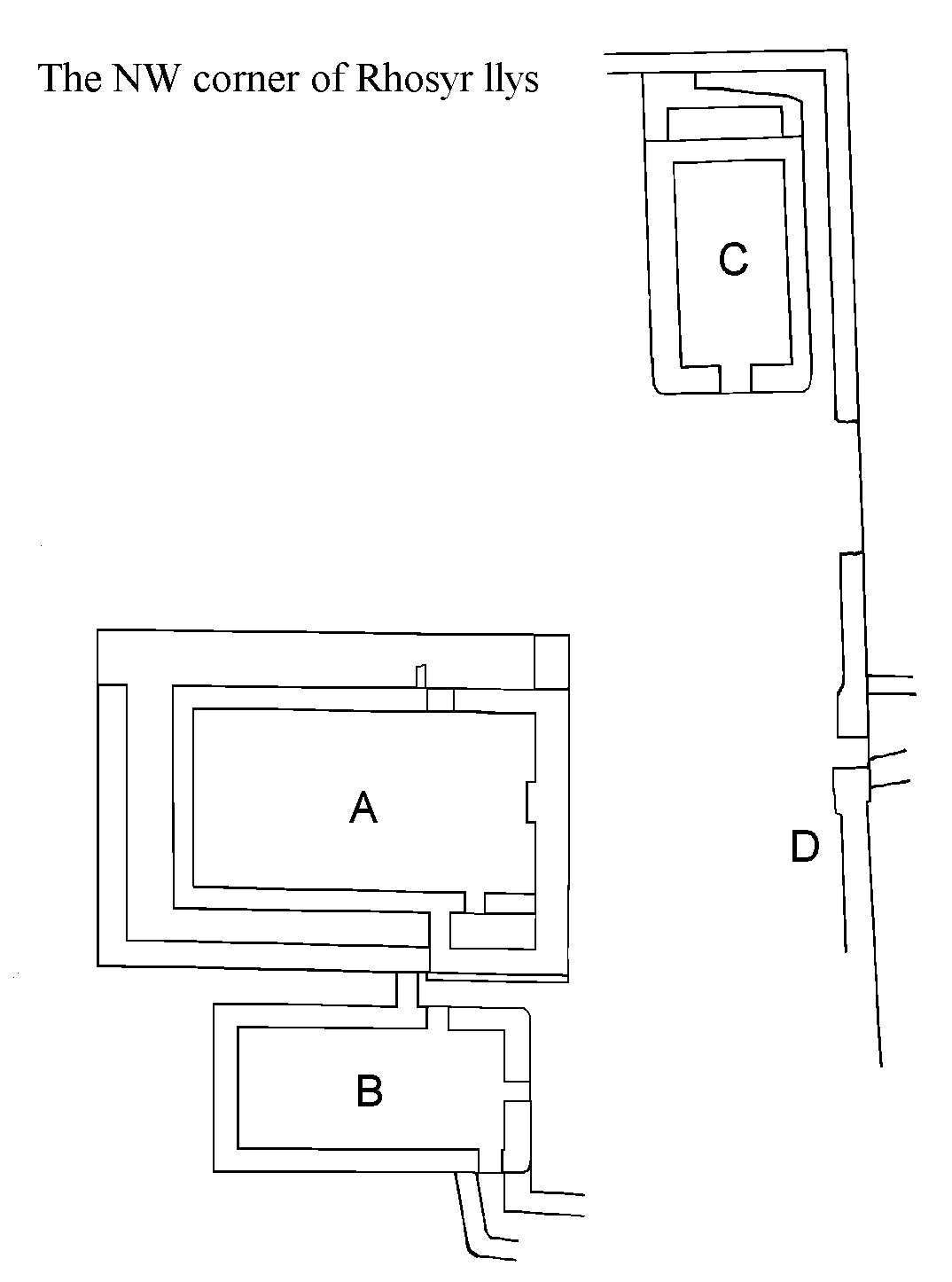 It is a shame that excavation did not
take place on the motte which would have shown if the masonry of the
keep was similar to that uncovered in the bailey. If it had
been we may have been able to tell if the whole structure had been
revamped after its destruction in 1094 when all the castles of Gwynedd
were certainly destroyed. This might have told us a great
deal about the site and the dates of its occupation. A small
dig upon the motte may well still show us the life span of the motte
and bailey castle.
It is a shame that excavation did not
take place on the motte which would have shown if the masonry of the
keep was similar to that uncovered in the bailey. If it had
been we may have been able to tell if the whole structure had been
revamped after its destruction in 1094 when all the castles of Gwynedd
were certainly destroyed. This might have told us a great
deal about the site and the dates of its occupation. A small
dig upon the motte may well still show us the life span of the motte
and bailey castle.
It has been asserted that the
foundations uncovered in Aber castle bailey can be related to the
rebuildings carried out for Prince Edward in the early fourteenth
century and that antiquarians often state that this was the site of the
llys. Neither of these arguments stand up to serious
consideration. The best preserved part of the structure is to
the north where one ‘wall' has been overlain by several large
river-worn boulders. The whole could be little more than
sleeper walls for a wooden structure. Certainly to describe
the foundations as they appear as a mansion or royal hall seems rather
grand and the reconstruction drawing of ‘the castle' as it
was said to have been in the early fourteenth century is positively
misleading, especially when compared to the one drawn for
Rhosyr. In the reconstruction at Aber the petty east entrance
into the primary building has lost its porch, while the low foundations
which have the appearance of sleeper walls have been imagined into a
two storey structure which positively dwarfs the motte and ignores the
industrial compound to the rear as well as the wall and ditch between
it and the motte.
It is worth noting that Aber castle
motte and bailey stands immediately west of the fast running Afon Aber,
just at the place where the river valley widens out into the coastal
plain. It therefore controls the river crossing and is in a
lowland position. It should again be emphasised that it is a
well recognised general principal that Welsh castles tend to dominate
the highlands and Norman castles the lowlands, although both sides on
occasions used the others' fortresses. It can therefore be
seen that the remains uncovered by excavation at this site are in
accordance with what has been found and is expected at other Norman
sites, but they do not meet with the criteria found at other llys
sites, viz Rhosyr.
Copyright©2016
Paul Martin Remfry
 It is perilous to precisely date any medieval structure, with or
without archaeological or documentary evidence. This is
because it is difficult to be sure what structures documents refer to
and even what exactly archaeological evidence actually
signifies. This is as true for castles as for
llysoedd. In each case it is still a matter of weighing
possibilities and deciding likelihoods. However, this does
not mean that such dating should not be attempted, merely that it
should not be set in stone, especially while much of the evidence is
yet to be evaluated.
It is perilous to precisely date any medieval structure, with or
without archaeological or documentary evidence. This is
because it is difficult to be sure what structures documents refer to
and even what exactly archaeological evidence actually
signifies. This is as true for castles as for
llysoedd. In each case it is still a matter of weighing
possibilities and deciding likelihoods. However, this does
not mean that such dating should not be attempted, merely that it
should not be set in stone, especially while much of the evidence is
yet to be evaluated.
 The aerial photographs of the dig site -
and a short personal inspection - would suggest the site has a complex
history which archaeology shows continued into the nineteenth century.
From the excavation reports we can judge that we are not yet anywhere
near to fully understanding the ‘modern' history of the
castle site after the Middle Ages.
The aerial photographs of the dig site -
and a short personal inspection - would suggest the site has a complex
history which archaeology shows continued into the nineteenth century.
From the excavation reports we can judge that we are not yet anywhere
near to fully understanding the ‘modern' history of the
castle site after the Middle Ages. The northern part of the excavation site
shows at least four or five phases and has obviously had a more complex
history than the two structures to the south, identified by Gwynedd
Archaeological Trust (GAT) as a hall and its later wing. This
northern section is also the best preserved part of the masonry and the
thickest, with the wall approaching 6' thick. In front
of the northernmost wall was a ditch which was not fully explored by
the excavators. This is a shame as it would appear to have
been the ditch dividing the northern bailey from the southern one,
which would make the northern wall of the excavated complex the curtain
wall of the southern bailey of the castle. This purported
curtain wall would appear to have been rebuilt with a new, narrower
wall topping the remains of the earlier one, of which only the northern
front can now be seen.
The northern part of the excavation site
shows at least four or five phases and has obviously had a more complex
history than the two structures to the south, identified by Gwynedd
Archaeological Trust (GAT) as a hall and its later wing. This
northern section is also the best preserved part of the masonry and the
thickest, with the wall approaching 6' thick. In front
of the northernmost wall was a ditch which was not fully explored by
the excavators. This is a shame as it would appear to have
been the ditch dividing the northern bailey from the southern one,
which would make the northern wall of the excavated complex the curtain
wall of the southern bailey of the castle. This purported
curtain wall would appear to have been rebuilt with a new, narrower
wall topping the remains of the earlier one, of which only the northern
front can now be seen. It is a shame that excavation did not
take place on the motte which would have shown if the masonry of the
keep was similar to that uncovered in the bailey. If it had
been we may have been able to tell if the whole structure had been
revamped after its destruction in 1094 when all the castles of Gwynedd
were certainly destroyed. This might have told us a great
deal about the site and the dates of its occupation. A small
dig upon the motte may well still show us the life span of the motte
and bailey castle.
It is a shame that excavation did not
take place on the motte which would have shown if the masonry of the
keep was similar to that uncovered in the bailey. If it had
been we may have been able to tell if the whole structure had been
revamped after its destruction in 1094 when all the castles of Gwynedd
were certainly destroyed. This might have told us a great
deal about the site and the dates of its occupation. A small
dig upon the motte may well still show us the life span of the motte
and bailey castle.